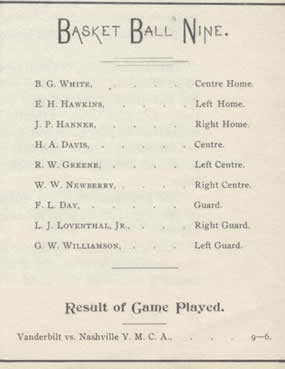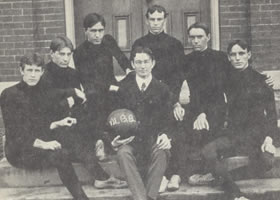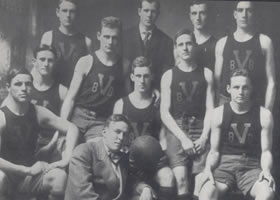Dec. 20, 2006
CHC- VU Basketball Began in 1893 (pdf) | CHC Archive
In the fall of 1891, Dr. James Naismith needed an indoor sport to avoid the bitter winter weather in Springfield, Mass. Naismith was asked to instruct the physical activities for the participants of the Young Men’s Christian Association Training School (later Springfield College).
At that time, the YMCA was a base for training physical instructors and general secretaries for the YMCA’s within the United States. Outdoor sports, such as football and rugby, failed to be converted to indoor sports. A small gymnasium was not equipped for a game requiring an enormous playing area.
 |
|
1893: VU defeats Nashville YMCA, 9-6 |
Naismith’s solution was to invent the game of “basket ball.” Peach baskets were secured from the custodian and hung from the gym’s balcony, which just happened to be 10 feet from the floor. He devised a set of rules that required nine players on a team and a soccer ball. The number of players on a team was derived to accommodate the 18 students in Naismith’s original class.
The new game began to spread within the United States and was the winter sport for the YMCAs in the country. Eventually, colleges and athletic clubs acquired the game for their use. Nashville, with its YMCA and athletic clubs, was quick to learn the game.
Vanderbilt’s interest in the game was evident when the university’s newspaper, Hustler, printed the rules in its Dec. 21, 1893 edition. At the time, football, baseball and track were the featured sports on the Commodore campus.
The Old Gym, which still exists today, housed these basketball games. The first known basketball game played by Vanderbilt as a team sport is recorded in the Comet, the university’s yearbook. The Comet reviews the 1893 “season,” a 9-6 victory over the Nashville YMCA. Also included in this yearbook are the names and positions of the nine Vanderbilt players.
Basketball became popular for several years as an intramural winter game on the Vanderbilt campus. Then in Feb. 1899, Dr. William L. Dudley, the Athletic Association’s President, sent a letter to Hustler, expressing his concerns.
Dudley’s letter was printed as follows:
The Executive Committee of the Athletic Association desires to express the hope that all students who expect to be candidates for the track, baseball and football teams of the university, in fact, all who have athletic ability, will avoid the game of basketball as played in our gymnasium.
Our athletics have had bitter experiences with this game in the past, and therefore the committee desires to give warning in due time.
The gymnasium is not adapted to the game, and the practice of playing it in their gymnasium suits is considered unsafe by all experts.
This game cost us the track championship of the Southern tournament last year and it is hoped that this year we may have winning teams in the field. To bring this result about we must have hearty cooperation of every student, and no chances should be taken in a game like basketball in which there is nothing at stake.
 |
|
1901 Vanderbilt Team |
Dudley’s advice to the students went unheeded, as a team was formed to accept a challenge from the YMCA in what would be Vanderbilt’s first official games. A three-game series was scheduled with the YMCA, the first contest played on Dec. 15, 1900.
W.D. Weatherford, became the first Commodore coach, had only one week’s worth of practice to prepare Vandy for the more experienced men at the YMCA. By this time, the number of players on a team was carved down to five. Weatherford’s starters were Walter Simmons, Ernest Reese, Tom Motlow, Herbert Gannaway and E.L. Woolf.
The first game was played at the Y’s gymnasium and the host won, 22-19. The Commodores faced a problem as a visiting team. They were not accustomed to the goals, as a writer for Hustler reported.
The game was handicapped by lack of team work, having had only one week’s practice, while Nashville’s team work was excellent, her team being for the most part composed of men who have played together for several years.
Another handicap to the Varsity was the fact that the baskets, instead of having solid wood backing from which the ball wound rebound, as the rules require, had wire netting behind them and a ball pitched just above the basket would almost invariably drop in it. The Y. M. C. A. team was accustomed to the gymnasium and made use of this fact, in pitching goals.
Vanderbilt trailed the game at halftime, 16-4 when a Commodore comeback was led by Simmons “who was all over the floor and who pitched nearly all of the goals.” With two minutes left in the game, Vandy cut the lead to 20-19, but the final basket by the Y-men ended the game, 22-19.
The second game of the series was played the following February with a surprising 24-9 Vanderbilt victory. Preceding the game on the Y’s gym was a gymnastic exhibition provided by members of the Vanderbilt gymnastic team.
The final game of the series was played in March as Hustler reported.
In the Y. M. C. A. gymnasium on Tuesday evening the basket ball team won the third and deciding game of the series with the Y. M. C. A. team by the very close score of 14 to 12. The Y. M. C. A. team’s play was surprisingly strong and the game was very exciting.
At the end of the last half the score stood 8-6 in favor of Vanderbilt. In the last four minutes of play Y. M. C. A. secured a lead of 2 points, but the Varsity immediately pitched another goal, making the score a tie, 12 to 12 at the end of the second half. In deciding the tie the play was fast and furious, but Perry finally landed the ball in the basket, winning the game for the Varsity.
The final game of Vanderbilt’s inaugural basketball season was played a week later at the Nashville Athletic Club. The gymnasium was packed “and the crowd was about evenly divided in its sympathies.”
 |
|
1908 Vanderbilt Team |
Hustler reported on the NAC’s 13-11 victory over Vanderbilt.
The basket ball game was one of the finest seen in Nashville this season. The N. A. C. team was composed of men who have played together for several years. They were all, with one exception, six footers and outweighed the Varsity at least twenty-pounds to the man. They expected to win an easy victory.
In the latter part of the first half the N. A. C. team seemed to play all around the Varsity, and when the whistle blew the score stood N. A. C. 10, Vanderbilt 5. The different arrangement of the goals in N. A. C. gymnasium seemed to greatly handicap the Varsity, for most of the pitches went wild and there was none of the team’s usual accuracy in pitching goals.
Simmons led a desperate Commodore comeback in the second half as Hustler continues.
Trusting to their superior weight, the N. A. C.’s began to play a rough game in the second half, and fared ill at it. Simmons brought down the house, figuratively, and almost literally, by throwing over his shoulder two of the N. A. C. men at once, each of whom were larger than he, in a way that was rather humiliating to the N. A. C. rooters Simmons’ play throughout the game was remarkable.
In case you were curious, Simmons was also a four-year starter for the Commodore football team. Vanderbilt’s inaugural season concluded with a 2-2 record.
The Vanderbilt basketball tradition began in the Old Gym. With the growth of basketball, leagues were formed with Vanderbilt eventfully joining the Southern Intercollegiate Athletic Association, Southern Conference and Southeastern Conference.
As the sport gained popularity in the South, Vanderbilt struggled to find an appropriate home. The Old Gym was used as a practice site and too small to accommodate a meaningful crowd. The Commodores would schedule future games at the old Hippodrome, YMCA, area high schools and David Lipscomb College’s McQuiddy Gym.
Then on Dec. 6, 1952, the dedication game of the university’s long-awaited campus gym was played against Virginia. Memorial Gymnasium was named for the Vanderbilt alumni who died in World War II.
Vanderbilt basketball has endured for 101 years with 25 head coaches and entering the 2001-02 season an overall record of 1,268-913 (58.1 pct.). The basketball tradition has produced such notable coaches as Bob Polk, Roy Skinner and C.M. Newton. And players like Pinky Lipscomb, Billy Joe Adcock, Clyde Lee, Perry Wallace (the first black player ever in the SEC), Jan van Breda Kolff, the F-Troop consisting of Jeff Fosnes, Joe Ford and Butch Feher, Jeff Turner, Phil Cox, Will Perdue, Billy McCaffrey, Drew Maddux, Dan Langhi, Matt Freije and many more that wore the black and gold with pride.
Next week read about the Nashville Y.M.C.A. Ramblers a tough rival to Vanderbilt in the early 20th century.
Traughber’s Tidbit: Terry Compton is the last Vanderbilt player to lead the team in scoring three years in a row when he did it from 1971-74. Compton averaged 17.3 points in 1971-72, 17.7 points in 1972-73 and 14.8 points in 1973-74.
If you have any comments or suggestions you can contact Bill Traughber via e-mail WLTraughber@aol.com.

